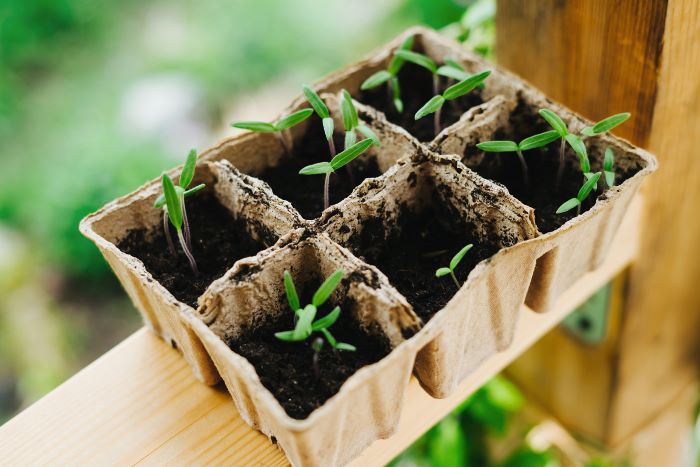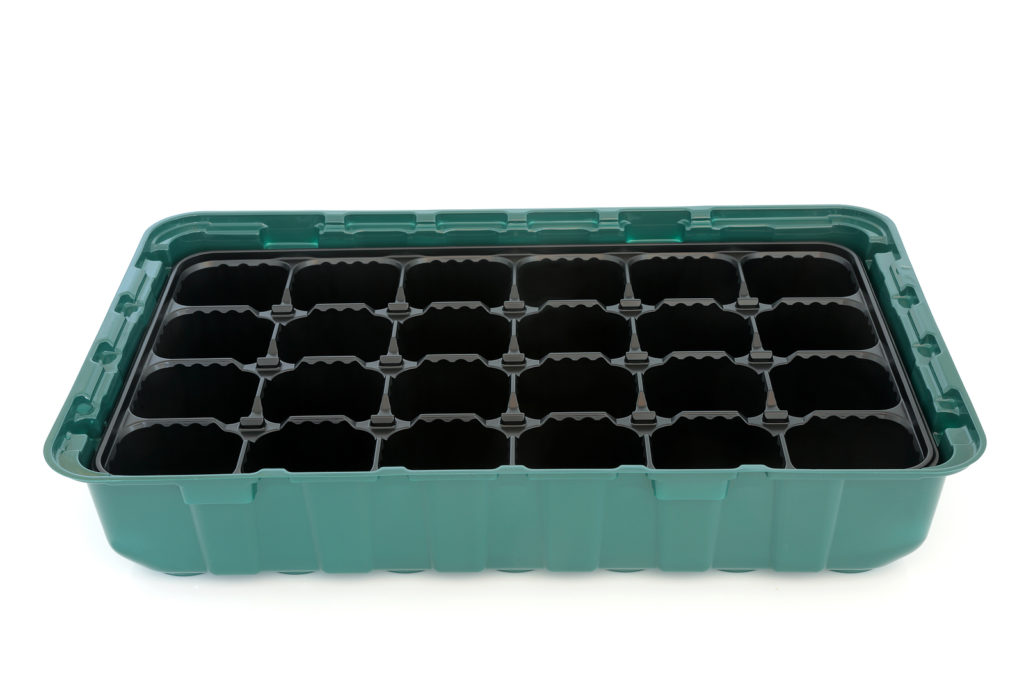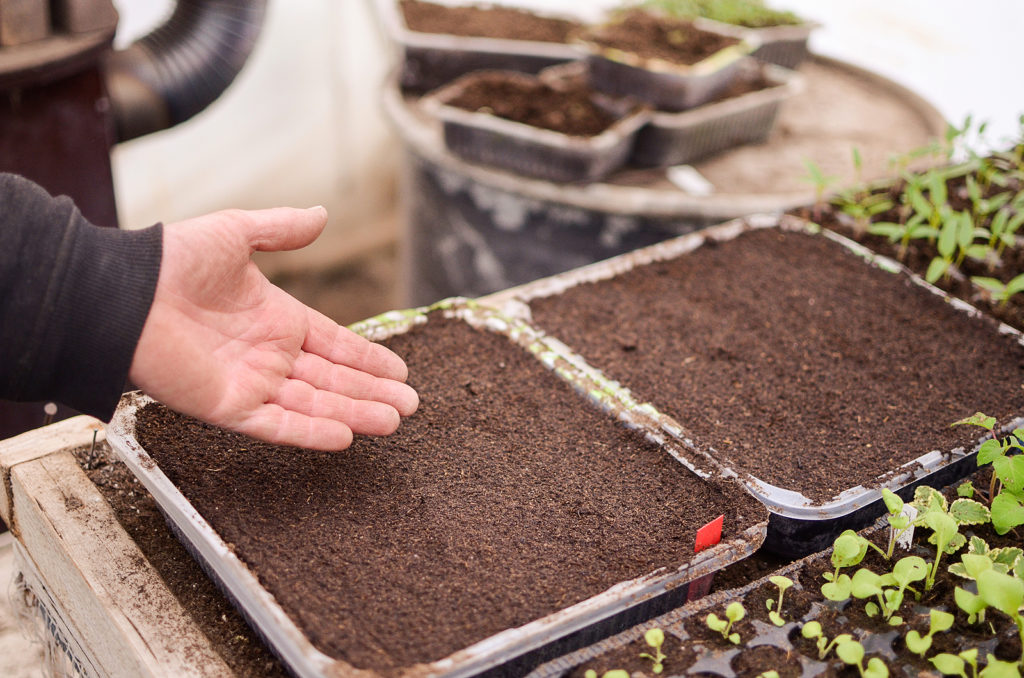Seed trays are essential for starting seeds and cuttings. Seed trays are commoly lightweight plastic, biodegrable paper, or compressed peat trays divided into separate cells, like a muffin tin, for growing individual seedlings.
Seed tray cells are usually 2 to 3 inches deep and up to 3 inches square or round. Some seed tray cells can be as small as 1 inch deep and 1 inch in diameter. Seed trays vary in size from small six packs (approximatley 4 by 8 inches) to as large as 12 by 20 inches or larger. Some seed trays come with a flat tray underneath to catch excess water. Some come with a plastic top or dome to create a small greenhouse.
There are many options available in the market. It can be overwhelming to know which one is the best fit for your needs. Here is a guide to seed trays and how they are used.

Types of seed starting trays
Choose a seed tray that suits your specific needs. There are various types available, including individual cell trays, multi-cell trays, and open flat trays. Individual cell trays are ideal for larger seeds or plants that require ample space, as each cell provides enough room for seedlings to develop. Multi-cell trays are perfect for smaller seeds or plants that can be closely spaced, as they provide multiple compartments in which to sow your seeds. Open flat trays, on the other hand, are versatile and can accommodate seeds of various sizes, allowing for greater flexibility.
Plastic sectioned starting tray
Lightweight plastic tray divided into separate cells usually 2 to 3 inches deep and up to 3 inches square or round. Plastic trays can be very thin and light or heavier. Some have flexible bottoms that allow rooted seedlings to be pushed out of the tray from the bottom.
Sectioned fiber seed tray
Compressed paper fiber or peat trays are similar in size and depth to plastic trays. Sometimes sold with plastic trays that they fit beneath the setioned tray to catch water that drips through. Some are designed especially to fit onto windowsills, called windowsill sets.
Open trays or flats
Open trays or flats do not have individual cells. Flats are often 6 to 12 inches wide and 12 to 24 inches long. They can be used for starting very small seeds that can be broadcast or scattered across the the starting medium surface. Seedlings grown in open trays or flats often need thinning so that individual seedlings can grow on without competion from neighboring seedlings.
Self-watering seed trays
Self-watering seed trays have drainage holes and capillary matting. An outer tray without drainable holes fit into the bottom of the starting tray. The seedlings are watered indirectly – water put in the bottom tray is pulled up into the starting tray.
Seed trays with plastic covers
Seed trays with clear plastic covers provide extra climate control at the germianitng stage. The plastic cover or dome fits over the top of the starting tray. The plainest version of this starting tray looks something like a casserole dish. Some have high domes that allow seedlings to grow to 3 or 4 inches tall. Seed trays with clear plastic lids act as mini-greenhouses, creating a moist and warm environment ideal for germination. Others have adjustable vents that allow for temperature and humidity control. These features can be particularly useful if you are starting seeds in colder climates and want to extend your growing season.

Seed tray use tips
- Sow two or three seeds in each compartment to compensate for poor germination. If more than one seed germinates, thin out the weakest, leaving only one seedling in each section.
- All seedlings in each tray should have the same watering requirements and planting times for ease of maintenance.
- The growing medium should be premoistened before sowing seed.
- Fiber or peat trays can be cut apart and completely buried in the garden (where the material will disintegrate nautrally). Trim off any part of the pot above soil line.
Seed tray material
Seed trays are commonly made of plastic or biodegradable materials. Plastic trays are durable, lightweight, and easy to clean, making them a popular choice among gardeners. Biodegradable trays, made from materials such as peat or coconut fiber, are environmentally friendly options that can be directly planted into the ground, preventing the disturbance of young plants during transplantation.
Plastic trays
Plastic trays are the most common choice due to their durability and affordability. They are lightweight, easy to clean, and provide good insulation for young plants. Plastic trays come in various sizes and designs. Plastic trays have excellent moisture retention, helping to create optimal conditions for seed germination. However, it is important to ensure that the plastic used is BPA-free to avoid any potential harm to your plants.
Some plastic trays are made from recycled materials such as recycled plastic or compostable materials; these are an excellent choice for reducing waste. Recycled trays often have the same benefits as traditional plastic trays, including durability and lightweight construction.
Biodegradable fiber or paper trays
Biodegradable trays made from materials like recycled paper, peat, or coconut coir are an eco-friendly alternative. These trays can be directly planted into the ground, reducing transplant shock and saving the gardener’s time and effort. Peat and fiber trays have excellent water retention capabilities and promote healthy root growth. Once seedlings are ready to be transplanted, the trays can be cut apart and the indivdual sectios can be planted directly into the ground. Peat and fiber trays can be more expensive than their plastic counterparts.

Seed tray depth
Seed trays can have cells of varying depth. Some types of plants have deeper root systems and require more space to grow, while others have shallower roots and can thrive in smaller cells. Make sure to choose a seed tray with the appropriate depth for the plants you are planning to grow.
Seed tray drainage
Seed trays must have drainage holes. Good drainage is essential for preventing waterlogging and ensuring healthy root development. Look for trays with good drainage capabilities to provide optimal conditions for your plants. Seed trays commonly have bottom drainage which allows excess water to easily escape. If water does not water easily drain away, seedling roots can become waterlogged and develop root rot. Bottom drainage allows for air circulation and prevents the build-up of harmful mold and fungus. Some seed trays feature small holes on the sides of the tray. This can provide a more controlled water supply to seeds.

Seed tray buying tips
- Seed trays come in various sizes, ranging from compact ones with just a few cells to larger ones with dozens or even hundreds of cells. Consider the space you have available and the number of plants you intend to sow before making your decision. If you have limited space or are sowing a small number of seeds, a smaller seed tray would be appropriate. On the other hand, if you have a larger garden or are planning to sow a significant number of seeds, opting for a larger tray will give your seeds more room to grow and develop.
- Ensure that the seed tray has adequate drainage holes. Proper drainage is crucial for seedling health as it prevents waterlogging, which can lead to root rot and other problems. Look for trays with sufficient drainage holes to ensure that excess water can easily escape, providing your seeds with the perfect balance of moisture.
- Sectioned trays are more expensive than the single flat often used by many professional growers. Sectioned tays are worth the extra money because they prevent root competition among seedlings as roots can devleop only within confines of each section — thus reducing transplant shock.
- Plastic trays can be reused year after year. Look for stiff, solid fabrication that will not easily break.
- Self-watering trays are easy to use and worth the extra cost if you find watering on a regular schedule difficult.
- Consider factors such as durability, moisture retention, and eco-friendliness when making your decision. By selecting the right seed tray material, you can create the ideal environment for your plants to thrive and ensure a successful gardening experience.
Related articles:
Choosing Plants for Containers
Flower Gardening in Containers
Container Vegetable Gardening Guide
Pot and Container Sizes for Growing Vegetable Crops
Container and Pot Sizes: How Much Soil Do I Need?
Grow Bag Vegetable Gardening Guide















